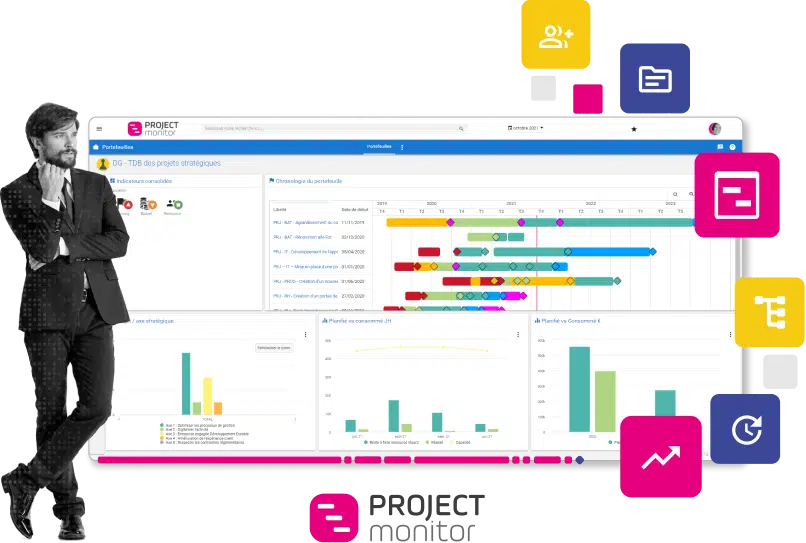How do you smooth out the workload?
The efficiency and success of a project portfolio depends on the ability to manage the workload in a balanced way. In an environment where resources are precious and limited, knowing how to distribute activities and projects wisely becomes essential. This is where workload smoothing comes in. An imbalance in the organization of workloads can entail major risks for the completion of projects within your company. Overworked employees run the risk of jeopardizing projects, suffering burnout, producing work of mediocre quality, or even leaving the company. At project level, this can disrupt team dynamics and even trigger internal conflict.
It is imperative to create and maintain a work environment that is both productive and healthy. This reduces stress, ensures project quality, strengthens team cohesion and increases productivity. To achieve this balance, an essential management approach is workload smoothing.
In this article, you will discover 5 steps for maintaining a productive work environment to smooth out your workload.
Recommended steps for smoothing the workload
Workload smoothing is a management technique designed to distribute resources evenly over a defined period. The aim is to avoid periods of overload or underload. This ensures that deadlines are met, and optimizes productivity, employee satisfaction and work quality. To balance the workload, you can adjust three elements: the duration of a phase/task, the number of allocated resources and the planning date.
Step 1. Define precisely the work capacity of each resource and the periods when they are available for the project.
First and foremost, it's crucial to model your resource pool. To do this, you need to know their capacity to work on the project, as well as their schedule constraints.
- Work capacity: This concerns the amount of work each resource can provide for the project. To obtain this capacity, we subtract various elements from the resource's availability. This includes part-time work (if the person only works part-time), vacations (vacations, days off, etc.), workload outside the current project, and an estimate of the load linked to unforeseen events.
- Calendar constraints: The calendar is the time base on which you plan the project. It is important to subtract days not available for work, such as public holidays, specific days off and other days of unavailability.
In other words:
- Project capacity = Total work capacity - Part-time - Leave - Non-project workload - Contingency workload.
- Calendar = Working days - public holidays - days of unavailability.
- It's important to note that an advanced planning parameter can include a variation in the cost of a resource depending on the allocation period, such as night, weekend or holiday work.
Step 2. Analyze your workload
One of the first steps in smoothing the workload is to assess the current workload. This involves assessing the tasks, projects and responsibilities of each team member. In addition, it's important to consider the duration of each task, the skill required to perform it, and the time needed to complete it.
Step 3. Identify peak and off-peak periods
Once you have an overview of the workload, identify periods when the workload is particularly high (peak periods) or low (off-peak periods). This information will help you to balance the workload over a longer period.
Step 4. Distribute tasks fairly
Once you've identified peak and off-peak periods, start redistributing tasks to smooth out the workload. This could mean postponing certain non-urgent tasks during peak periods, or bringing forward certain tasks during off-peak periods. It's important to take into account the skills and preferences of each team member when redistributing tasks.
Step 5. Evaluate and adjust regularly
Finally, workload smoothing is not a one-off process, but an ongoing one. It's important to regularly assess the workload and adjust the plan as necessary. Changes in projects, priorities and team members' availability may require regular adjustments.
Use a project portfolio management tool to smooth out the workload
With its advanced features, Project Monitor lets you :
Tracking resources' time and tasks: This can help identify employees who are overloaded and those who have too little to do.
Create reports:These can be used to identify potential problems and take steps to resolve them.
Share information & collaborate:This can help avoid overlapping and conflicting tasks.
If you'd like to find out more about how Project Monitor can help you balance the workloads of your resources, ask for a personalized demonstration.
💡 To remember
Workload smoothing helps improve productivity and team satisfaction, while ensuring better quality of work. Although it can take time and effort to implement and monitor, the long-term benefits are significant. The number of parameters involved in workload smoothing (projects, phases, resources, skills, company schedules, resource schedules, etc.) makes the use of dedicated software essential. The "office" approach does not allow you to manage all the data and their interdependencies without an "Excel macro factory". All the more so when you want - and this is key - to involve project resources directly in the process.
Other frequently asked questions about resource management
How do you calculate the number of resources needed for a project?
Who allocates resources to the project?
What resources are needed to make a project a success?
How do you calculate a project's workload?
How to distribute the workload?
How to draw up a successful workload plan to effectively manage project resources?
Project Monitorresource & project portfolio management software
All the tools for resource management (and more). All in one software package.
Discover the features of Project Monitor, resource & project portfolio management software designed to meet the needs of PMOs, CIOstructures with more than 50 employees, or managing complex projects.
Easily manage over 100 active projects and pilot your action plans. Get a complete overview of what's happening in your project portfolio: resources, schedulebudget, dashboards.
